The project of the houseboat-catamaran «Cinderella»
The houseboat-catamaran «Cinderella», the project of which is offered to the attention of amateur shipbuilders, is small in size, but it will be possible to spend a vacation on it even in more comfortable conditions than on a 5-6-meter boat. Its main advantage is the presence of a tall, human—sized (1.73 m) and light cabin (2.0x1.9 m in plan) with a floor at the level of the «promenade deck» fore and aft «verandas». At the same time, the «Cinderella» has all the advantages of a collapsible tourist boat designed for movement with an economical outboard motor of low power.
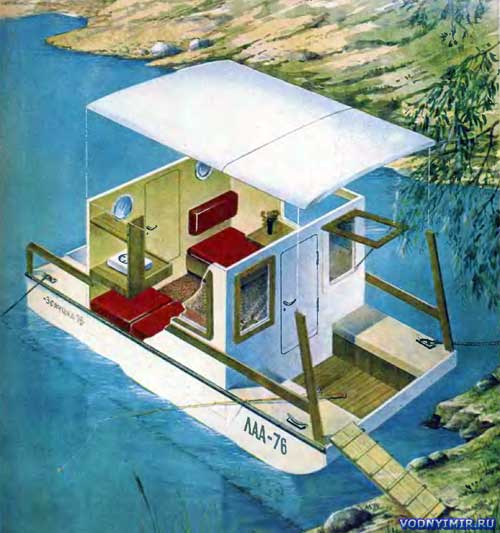
Small dimensions and simplicity of contours guarantee minimal labor intensity of construction; it is important that you can build a floating catamaran «Cinderella» in an ordinary city apartment. The housings of the floating unit are disassembled each into two parts of 2-meter length, which freely pass through the doors and along the stairwell. The dimensions of the «slipway», determined by the size of the largest section — the superstructure pallet, are 2.0x1.9 m. The weight of the heaviest section is 60 kg.
It is possible to transport a floating boat by truck, and in a completely disassembled form — to hand over in luggage for shipment by rail. When choosing a vacation destination, do not forget that «Cinderella» is not designed for swimming on large rivers and reservoirs. The significant windage of the superstructure makes it difficult to move in a fresh wind, a small clearance (0.2 m from the catamaran bridge to the water surface) will cause strong impacts on the waves. The ideal place to relax on the «Cinderella» are small rivers and closed lake systems with numerous islands — like Vuoksa or Seliger, or quiet forest lakes.
| Basic data of the houseboat-catamaran «Cinderella»" | |
|---|---|
| Longest length, m | 4,07 |
| Maximum width, m | 2,04 |
| Overall height, m | 2,25 |
| Draft, m | 0,27 |
| Assembly weight (without supply), kg | 350 |
| Total displacement, kg | 750-800 |
General view of houseboat-catamaran «Cinderella» assembly
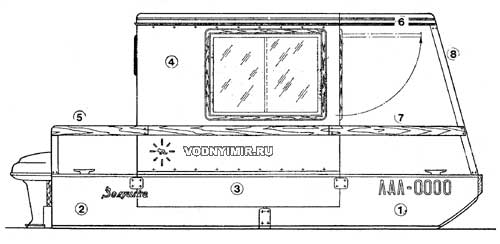
1, 2 — fore and aft sections of the right hull-catamaran float; 3 — pallet: 4 — deckhouse-superstructure assembled from five planar sections on a pallet; 5 — aft handrail; 6 — roof section of the bow «veranda»; 7 — bow handrail; 8 — roof rack.
When designing the floating boat, a family crew of three people was meant. You can, of course, sail on it and another company, but accordingly you will need to redevelop the cabin.
The relatively narrow (0.5 m) floats of the catamaran allow you to reach a speed of 10-12 km/h with a 5-8 hp motor. In most cases, you can do with a 2-strong «Salute»; the speed of 6-7 km/h is usually enough to travel across the lake from island to island.
The design of the houseboat-catamaran «Cinderella»
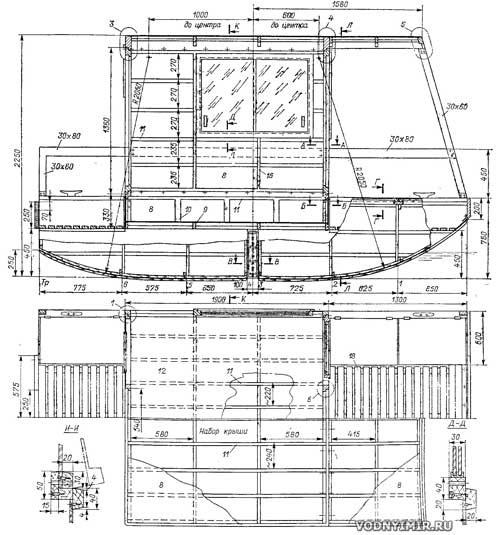
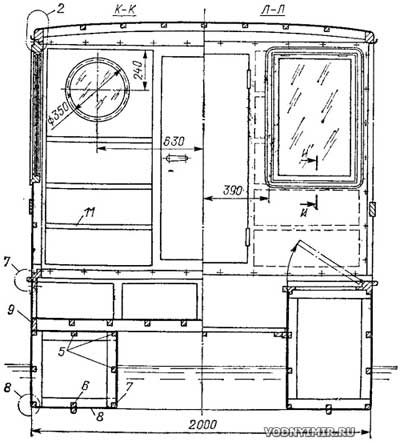
1 — side branches of frames, 20x50; 2 — bottom hinges of frames 20x60; 3 — beams 20x50; 4 — transom and bulkhead cladding, plywood δ=5; 5 — stringer and carlengs, 20x30; 6 — stringer 30x30, glued from three rails 10x30; 7 — stringer 20x30, glued from three slats 10x30; 8 — lining of floats, roof and cabin sections, plywood δ=5; 9 — pallet frame and beams, 20x60; 10 — vertical bars of pallet frame, 20x50; 11 — bar 20x30; 12 — flooring in the cabin, plywood δ=8; 13 — polik bars 20x60; 14 — binding of cabin section frames, 25x45; 15 — bar 25x25; 16 — cabin section racks, 20x45; 17 — cabin pallet strapping bar, 25x50; 18 — 20x60 rack rails.
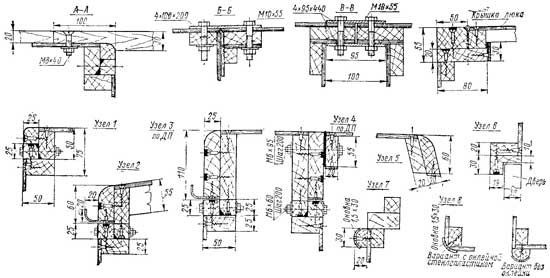
The construction is based on 4-meter float housings; when assembled houseboat-catamaran the bow and stern sections of each of them are connected by bolts M10x55 through metal slats. In the decks of the floats, hatches are cut with lids, allowing the use of internal volumes for storing property and supplies (bow sections), motor and fuel (aft).
Assembly of the bow section of the left float of the houseboat-catamaran
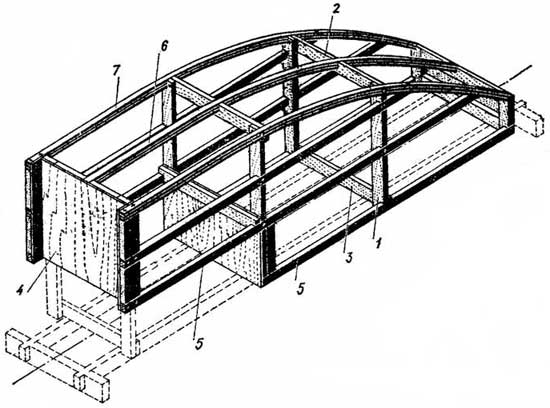
The dotted line shows the descriptive details.
The blanks for the parts of the set are cut from pine slats. To assemble rectangular frame frames, you must first draw them in full size on a sheet of plywood or cardboard. It is recommended to specify the height of the frames according to the «side» projection by constructing the fillets of the keel line at the extremities along an arc with a radius of 2045 mm. The frames are assembled on a water-resistant adhesive (epoxy or VIAM B-3) with screws pressed in.
Frame frames for assembling floats

The dotted line shows the parts that are removed after the plywood cases are finished.
Position designations — see «Catamaran floating structure» above.
On shp. 3, 4 and 5 (the area where the pallet is installed), the side branches are made of the same length as on the other frames; this is necessary for the convenience of attaching the frames to the slipway, the free ends are sawed off after removing the float from the slipway.
The frames are installed with the bottom up strictly vertically on the simplest slipway of two boards placed on an edge and rigidly connected to each other. If space allows, it is better to assemble a whole float at once, and then cut it into two parts along the length. When assembling sections separately, it is necessary to carefully check the accuracy of the manufacture of the joined frames on shp. 4 and 3.
After installing and leveling the frames, the zygomatic and bottom stringer of 10-millimeter slats bent in place are glued to them. Then the rest of the longitudinal set of 20x30 straight bars is installed and all the surfaces of the set in contact with the skin are rounded.
Individual sheets of 5 mm waterproof plywood are pre-bonded with glue («on the mustache») to obtain parts of the required dimensions. If it is possible to paste the floats with fiberglass, the thickness of the lining can be reduced to 4 mm. The skin is attached to the set on a waterproof adhesive with 4x20 screws pressed into it.
Then the sections of floats are removed from the slipway, the deck set, the hatch frames and the deck flooring are installed in the pallet area. Work on the floats is completed by installing collars with shackles and thrust bars for polik.
The superstructure consists of a pallet — flooring connecting the floats with walls 355 mm high along the perimeter and five planar sections of walls and roof. These sections, when assembling the cottage, are connected with M6x60 bolts, delivered in 200 mm increments; the seal is a cord made of foam rubber, usually used when sealing windows for the winter.
Assembling the cutting pallet
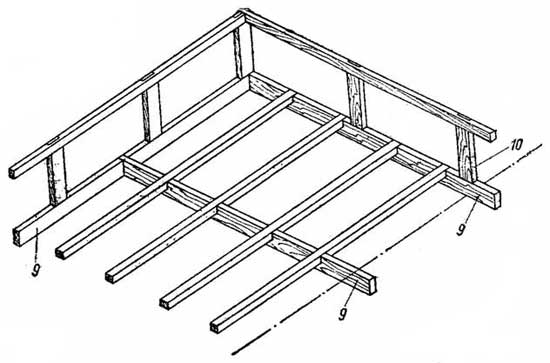
The assembly of the sections themselves is carried out directly according to the markings made on any flat flooring. The bars are attached to the shorties installed along the marking lines. All the bars that make up the set of sections of the superstructure are cut into one another or cut into half a tree using glue. The assembly of the pallet is completed by installing a rigid mounting frame assembled in advance on the upper edges of its sides, on which sections of vertical walls will stand.
The assembly of the walls of the superstructure begins with the binding of frames, into which the ends of the vertical and horizontal slats of the set are cut. After sewing with plywood, edging bars (25x25) are placed around the perimeter of each section, covering the ends of the plywood. The roof of the superstructure and the rigid awning of the bow «veranda» are covered from the outside with a dense fabric on thickly rubbed paint. The edges of the fabric are fixed with gutters-water collectors and pressure metal strips. You can, of course, glue the roof with thin fiberglass (fiberglass mesh) on epoxy resin.
In addition to the pallet, the catamaran floats are connected by two beams glued out of 30x60 bars. The aft beam serves as a motor board, so it must be reinforced with plywood linings on both sides.
The handrail consists of a horizontal bow and aft L-shaped parts, which are attached with M8 screws to the walls of the superstructure, to the awning rack — in the nose and a metal shorty — in the stern. The bow posts of the awning are also fastened with the help of a short square and bolts.
The floorings between the floats on the aft and bow «verandahs» are latticed poles resting on horizontal bars placed on the inner sides of the floats. It is advisable to make these polices from separate sections with a length of about 400 mm.
Doors with a size of 540x1220 are shields with a binding of 20x30 bars, sheathed on both sides with plywood. Before installing the stitching, it is necessary to put the bosses in the place where the handle and lock are attached. The ends around the perimeter of the door should be closed with a protective rail 10x30.
To build a houseboat-catamaran «Cinderella», pine bars and slats with a length of 2.2 m (taking into account 10% of the stock) will be required in the following quantity: 10x20 — 28 pieces in cross section; 10x45 — 5; 15x50 — 2; 20x20 — 5; 20x25 — 2; 20x30 — 80; 20x40 — 4; 20x45 — 3; 20x50 — 10; 20x60 — 28; 20x75 — 2; 30x60 — 10; 20x80 — 3; 20x90 — 6; 25x25 — 23; 25x45 — 20; 25x55 — 2; 25x60 — 2; 25x105 — 4; 25x110 — 4; 30x40 — 2; 30x30 — 4; 30x80 — 34; 35x50 — 3. As a result, it will be 0.43 m. Plywood will need: 5 mm thick — 15 sheets, 8 mm thick — 2 sheets.
Side sliding windows are cut out of plexiglass with a thickness of 6 mm and placed on plastic furniture profiles-runners. From the inside, handles made of 20x25x80 solid wood bars are attached to the glasses with screws. Window frames are assembled from 30x40 bars connected by half a tree. Outside, a 20x40 rail trim with beveled edges is attached to the frame. The platband protrudes beyond the edge of the frame in the form of a flange. This design allows you to make windows separately and mount them on ready-made sections of walls.The bow windows are suspended on hinges mounted on the upper edges. The frame is made of 20x30 bars, plexiglass is attached directly to it with screws sealed with thick-rubbed paint. In the raised position, the glass is fixed with a hook attached to the roof beams.
It is recommended to make shutters for all windows from plywood flaps fixed with screws with lambs to the frames.
The aft portholes are round and deaf. They are best installed on an automotive rubber sealing profile; if necessary, a chamfer is removed along the edge of the glass.
Hatch covers on floats are made of 5 mm plywood with a binding of 30x30 bars. In order for the plywood not to bend, 20x30 transverse bars are cut into the frame. The difference in the height of the frame bars is explained by the presence of a plywood coaming that prevents water from entering the float through the hatch. It is desirable here to protect the ends of the plywood along the perimeter by cutting its edge into the bar (in this case, the section of the workpiece will be 35x30) or by installing a protective rail, as provided by the design of the doors.
Mooring ducks are cut from 30x50x200 solid wood bars and fastened with through bolts.
Washers must be installed everywhere under the heads of bolts and nuts of connections. Under the metal lining of the connections of the pallet and floats, as well as under the connections at the ends of the cross beams, it is necessary to lay rubber 2-4 mm thick.
The most «spartan» version of the cabin equipment is two folding beds and a hinged galley table. The color drawing placed at the beginning of the article shows a more comfortable option designed for a family of two adults and a child. In this case, two longitudinal sofas with soft pillows are installed. The sofa on the left side is transformed into a «dining area» consisting of a folding table and two upholstered seats, the backs of which are parts of the middle cushion of the sofa.
The front cushion of the right sofa is made with a rigid base; being laid on the middle cushion, it forms the driver's seat. In front of him, a steering wheel is attached to the bow wall of the superstructure, and a remote control of the motor is attached to the side wall. A galley table with a shelf for dishes is hung above the rear section of the right sofa. Drawers for beds and food storage are provided under the sofas.
One of the options for the floatation layout
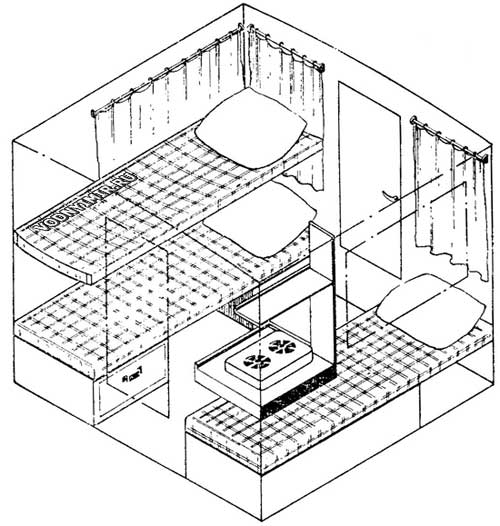
The third berth is made in the form of a suspended canvas bunk above the left sofa. The same bed, of course, can be installed symmetrically — on the starboard side, but in this case the galley table will have to be removed for the night. Light curtains with cheerful coloring will give the room a homey feel.
It should be remembered that the Cinderella is a real vessel and any voyages on it must be preceded by registration with the navigation and technical inspection. On board the floating boat, rescue supplies should always be in full readiness according to the number of people resting on it.
I especially want to warn you about the need to be careful with fire. For fire safety, ventilation must be provided in the aft sections of the floats, which would prevent the formation of an explosive mixture of gasoline vapors with air. The ventilation system consists of holes with visors on the top of the inner walls of the floats (two in each section). A hose or tube should be connected to one of the holes, almost touching the bottom of the float.
In conclusion, a few words about one feature of catamarans. All double-hulled vessels have a high initial stability (in full load, the roll of the Cinderella when moving the entire crew on one side will not exceed 5-7°), but are prone to a sharp rollover when the critical roll angle is reached. For «Cinderella» it is 15-20°. Make sure that your houseboat-catamaran does not get a big roll!
Boat projects for self-construction
Share this page in the social. networks or bookmark:
